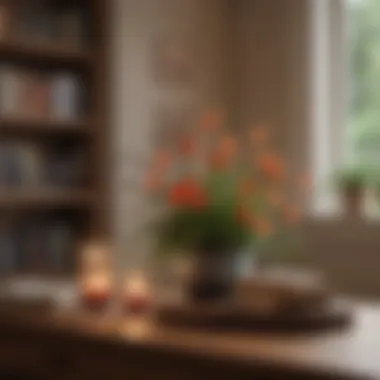Transform Your Home Atmosphere with Fragrances


Intro
Fragrance is an often overlooked element in home environments. It plays a crucial role in shaping one’s experience within living spaces. The right scent can elevate mood, complement decor, and foster well-being. Understanding how to effectively incorporate thoughtful fragrances into your home can make a significant difference. This guide will explore various dimensions of fragrance, including its application methods, the current trends in design, and the connection between plants and scent. The insights provided aim to inspire homeowners, interior design enthusiasts, party hosts, and gardening aficionados alike.
Design Inspiration
Current Trends in Interior Design
Today’s interior design trends increasingly reflect an awareness of scent's importance. Homes are more than just spaces filled with furniture; they are personal havens where scent harmonizes with aesthetics. Open floor plans remain popular, allowing fragrances to traverse spaces freely. The concept of biophilic design has gained traction, emphasizing the inclusion of natural elements, including plants that contribute both to decor and fragrance.
In 2023, a focus on sustainable materials continues to permeate the design landscape. Natural fabrics, wood finishes, and organic shapes create a serene ambiance. As homeowners prioritize wellness and natural living, incorporating scents derived from plants enhances this holistic approach. The emphasis on experiences over possessions fosters a desire for unique items, including bespoke fragrances that reflect personal taste.
Color Schemes and Palette Ideas
When selecting a color scheme for your space, consider how colors can affect mood and, subsequently, the perception of scent. Soft, muted tones, such as pastel greens or gentle blues, evoke calmness and can be paired with delicate floral or herbal fragrances for a cohesive atmosphere.
Here are some engaging color palettes to consider:
- Nature-inspired Greens: Sage, olive, and forest green paired with energizing scents like basil or rosemary.
- Earthy Neutrals: Beige, mocha, and taupe combined with warm, woody fragrances like sandalwood or cedar.
- Cool Blues: Light blue or teal with refreshing scents such as eucalyptus or peppermint.
Mixing and matching these color schemes with specific fragrances lets you create a more immersive environment. Experiment with lighting and accessories that will bolster the chosen tones and scents, achieving an inviting space.
Gardening Techniques
Plant Selection and Care
Incorporating plants into your living area is a powerful way to enhance fragrance. Herbs such as lavender and mint are not only fragrant but also practical for culinary use. When selecting plants, consider their care requirements, such as light and humidity.
Some excellent options for indoor fragrances include:
- Lavender: Known for its calming scent.
- Jasmine: A floral fragrance that enhances relaxation.
- Mint: Fresh and uplifting aroma, great for kitchens.
Caring for these plants involves ensuring appropriate watering and light exposure. Regular pruning helps maintain healthy growth and keeps the fragrance strong.
Indoor vs. Outdoor Gardening
While both indoor and outdoor gardening play a role in fragrance, each has unique advantages. Indoor gardening allows for year-round enjoyment of fragrances in your living areas. Outdoor gardening provides more space for larger plants or creating a fragrant garden. The choice depends on available space and personal preference.
Utilizing both can create a layered fragrance experience. Consider the ease of incorporating small indoor pots while establishing aromatic garden beds outside.
"Fragrance is the essence of place; it's not just an embellishment but an integral piece of your environment."
Culmination
The Importance of Fragrance in Interior Design
Fragrance plays a pivotal role in interior design, offering a multi-sensory layer to the atmosphere of a living space. This aspect goes beyond mere decor; scent can transform how we experience our environment. Thoughtful fragrances can elevate the overall ambiance, influencing not only how a room looks but also how it feels and is perceived by occupants and guests.
In this exploration of fragrance, we will examine several key components, each underlining the essential role scent plays in shaping an inviting and personalized home. We shall consider how scent integrates with design elements, the impact on emotional responses, and the potential for creating a distinctive atmosphere that aligns with individual preferences.
Understanding Scent Perception
Scent perception is a complex interplay of biology and psychology. The human olfactory system is directly linked to the limbic brain, which is responsible for emotion and memory. This connection means that scents can elicit strong emotional reactions and recall personal memories.
For instance, the warm and woody notes of cedarwood might evoke feelings of comfort, while the crispness of citrus can stimulate alertness. When selecting fragrances for your home, consider the feelings you want to inspire. Each person's reaction to scent is unique and influenced by personal experiences.
How Fragrance Affects Mood
The psychological effects of fragrance can be profound. Research indicates that certain scents can reduce stress, enhance focus, or facilitate relaxation. For example, lavender is well-known for its calming effects, often used in bedrooms or relaxation areas. On the contrary, invigorating scents like peppermint or eucalyptus can be beneficial in workspaces, fostering energy and concentration.
Choosing the appropriate fragrance for your space can thus influence not only your mood but also the mood of guests. A well-chosen scent can create an inviting and appealing atmosphere during gatherings, enhancing the overall experience of those present.
Scent and Memory Connection
One of the most intriguing aspects of scent is its strong association with memory. The concept of scent as a trigger for recollection is well documented. A particular fragrance can transport individuals back to a specific moment in time, making it a potent tool in interior design.


Incorporating scents into your space can create a signature experience for you and your visitors. Whether it is the smell of freshly baked cookies to welcome guests or the subtle hint of vanilla that recalls family gatherings, these sensory connections can enhance the warmth and familiarity of your home.
Consider that a distinctive scent can become part of your home identity, creating lasting impressions on visitors and family members alike.
Scent has the potential to embed itself in the collective memory of a household, influencing its legacy through the years. This dialogue between fragrance and memory adds depth to interior design strategies, transcending the simple visual elements we commonly focus on.
Choosing the Right Fragrance for Your Space
Choosing the right fragrance for your living space is a significant step for enhancing your environment. Scent not only affects the mood but also complements the overall aesthetic of a room. When selecting fragrances, it's essential to consider the factors that contribute to creating an inviting and harmonious atmosphere. Pay attention to how different scents can create unique responses in individuals, thereby personalizing the overall experience in your home.
Identifying Personal Preferences
Understanding your preferences is the first step. Each person has a distinct sense of smell. Some may gravitate towards floral notes, while others might prefer earthy or citrus scents. To identify your preferences, take the time to experience different fragrances individually. Visit stores that offer testers so you can evaluate scents without commitment. Take note of how specific scents make you feel. Create a list of your favorites; this will guide you in making choices that resonate with your personal style.
Fragrance Profiles: An Overview
Fragrance profiles consist of various notes categorized into three main levels: top notes, middle notes, and base notes. Each of these plays a crucial role in the overall scent experience.
- Top notes are the initial scents detected immediately upon use. They are often fresh and light, like lemon or mint.
- Middle notes emerge once top notes evaporate. They form the core of the fragrance, often characterized by more potent scents like lavender or jasmine.
- Base notes develop as the fragrance dries down. These scents linger longer and give depth, such as sandalwood or vanilla.
Understanding these profiles can assist in curating fragrances that merge well together, enhancing your living space holistically.
Synergy with Interior Design Themes
The fragrance in a space should align with its interior design theme. For example, a minimalist decor could benefit from simple and clean scents like eucalyptus or fresh linen. On the contrary, a bohemian style might embrace deeper, more complex fragrances that include notes of patchouli or warm spices. Consider how fragrances can enhance the visual qualities of your decor. For instance, placing a floral-scented candle on a rustic wooden table underlines the natural aesthetic in the room. When you allow fragrance to complement your design theme, the overall ambiance of a space can become more cohesive.
"The correct fragrance can not only enhance your mood but also underline your interior design choices."
Investigating these elements can guide you toward making informed decisions. By taking time to understand personal preferences, fragrance profiles, and the synergy with your home’s design, you can significantly enhance your living space.
Methods of Fragrance Application
The application of fragrance in your living space is a pivotal aspect of creating an inviting atmosphere. It not only influences the overall aesthetic but also can enhance mood and well-being. Selecting the right fragrance delivery method involves understanding the benefits associated with each option. Some methods offer immediate scent release, while others provide a more gradual and sustained aroma.
Scented Candles: A Classic Choice
Scented candles have been a staple for adding fragrance to home environments for centuries. They are celebrated for their warmth and ambiance, making them an excellent option for various occasions. The flickering candlelight creates a cozy atmosphere, inviting relaxation.
When choosing scented candles, consider the following:
- Quality of ingredients: Opt for candles made from natural waxes like soy or beeswax. These tend to burn cleaner than paraffin alternatives.
- Fragrance load: Look for brands that provide a higher concentration of scent, ensuring a stronger and long-lasting aroma.
- Burn time: Candles differ in burn durations; a longer burn time might be more economical for regular use.
However, it’s important to keep safety in mind. Always place candles in stable holders and never leave them unattended while lit.
Essential Oil Diffusers: Modern Options
Essential oil diffusers offer a contemporary approach to fragrance application that appeals to those seeking therapeutic benefits. This option allows users to enjoy pure essential oils, which can enhance well-being through aromatherapy.
There are various types of diffusers available, including:
- Ultrasonic diffusers: These create a fine mist of water and essential oil, providing humidification alongside fragrance.
- Nebulizing diffusers: These do not use water but atomize essential oil directly, delivering a stronger scent.
- Heat diffusers: By gently warming the oils, they release fragrance but may alter the oil's properties.
When using diffusers, ensure proper ventilation in the space, as high concentrations of essential oils can be overpowering. It’s key to select oils that align with your mood or aim to achieve a particular atmosphere in your living room.
Incorporating Natural Elements
The use of natural elements for fragrance not only introduces delightful scents but also brings the beauty of nature indoors. Options include:
- Fresh flowers: Bouquets such as gardenias or jasmine can add their scents to the environment while also enhancing the visual appeal.
- Herbs: Sprigs of rosemary or mint can provide a subtle yet refreshing aroma, perfect for kitchen areas or dining rooms.
- Potpourri: This classic option allows for a blend of scents using dried flowers, spices, and herbs.
Using natural elements is sustainable. They can often be composted or allowed to dry for other uses, aligning with eco-friendly practices. Incorporating these options can create a layered scent experience, enhancing both physical and emotional comfort.
Seasonal Fragrance Considerations
The seasons profoundly influence our mood and preferences, extending even into the choices we make regarding fragrance in our living spaces. Each season comes with its own unique qualities that can be captured and enhanced through scent. Embracing seasonal fragrances allows homeowners to reflect the shifting environment within their homes in a meaningful way. This consideration not only enhances the ambiance but can also evoke specific memories or feelings connected to that time of year. Understanding how to select and apply fragrances according to the seasons provides several benefits such as creating a welcoming atmosphere and improving overall comfort in the home.
Warm Scents for Winter
As the cold months approach, we often seek comfort and warmth. Choosing warm scents for winter creates an inviting atmosphere. Fragrances like cinnamon, vanilla, and clove are excellent candidates during this time. These scents evoke feelings of coziness and can remind individuals of holiday gatherings or warm evenings by the fireplace. Additionally, incorporating these fragrances can enhance the enjoyment of seasonal activities, making home life feel more festive. Consider using scented candles or essential oil diffusers to spread these warm scents throughout your living room.


Fresh and Floral Scents for Spring
Spring symbolizes renewal and growth. This is an ideal time to introduce fresh and floral scents, as they can invigorate the space and uplift your mood. Lavender, peony, and lilac are some examples that can significantly enhance the spirit of the season. The fragrances of cherry blossoms or freshly cut grass can transport you to warmer days while encouraging openness and new energy in your living environment. Fresh and floral scents work well during gatherings or simply to enhance your daily routine. They can be effectively applied through potpourri or essential oil diffusers for a light fragrance profile.
Citrus and Bright Scents for Summer
Summer is synonymous with brightness and vibrancy. Embracing citrus and bright scents like lemon, lime, and grapefruit can invigorate the atmosphere during this season. These scents not only add freshness to your space but also promote alertness and energize the mind. Their ability to uplift spirits aligns well with the activities that many people engage in during the summer months, such as outdoor entertaining or relaxing with family. Inclusion of citrus scents can be achieved through natural candles or essential oils.
Earthy Scents for Fall
As the leaves change color and a chill enters the air, earthy scents become particularly appealing. Scents like sandalwood, patchouli, and cedarwood can add depth and warmth to your home. These fragrances can foster feelings of stability and comfort as one prepares for the cozy months ahead. Additionally, earthy scents can evoke a connection to nature and the changing landscape outside. Using an oil diffuser with these scents will ensure your space is welcoming as you transition from the bright summer into the rich tones of fall.
Creating a Signature Scent for Your Living Room
A signature scent holds a unique significance in establishing the ambiance of a living space. The right fragrance can transform a room, imparting warmth and comfort. Developing a signature scent for your living room is not merely about choosing a pleasant aroma; it involves creating an olfactory experience that resonates with the identity of your home. This tailored scent can evoke positive emotions, enhance gatherings, and create memories.
When considering how to create your signature scent, think about the essence of the room. Factors like furniture style, color palette, and the overall theme influence how fragrances will be perceived. It is essential to select scents that complement rather than overpower other elements in your space. Personal preferences play an integral role, allowing you to develop a setting that feels intimately yours.
Layering Different Fragrances
Layering fragrances is an art form that can lead to a complex, yet harmonious, aromatic experience. Start by selecting a base scent that serves as the foundation. Common base scents include sandalwood, amber, or vanilla. Next, consider adding middle notes such as lavender or jasmine, which can bring richness and depth. Finally, top notes like citrus or mint introduce a fresh lift.
Use these layers strategically. For example, when hosting a gathering, place fragrance diffusers in various corners of the room, ensuring the base and middle notes mingle subtly, creating a cohesive scent profile. Experiment with combinations at different times of day, as a scent may evolve with changing light and environment.
Balancing Intensity with Environment
Striking the right balance in fragrance intensity is paramount. A scent that is too strong can become overwhelming, especially in smaller spaces. Conversely, a scent that is too light may not leave a lasting impression. Consider the size of your living room and the type of activities that take place within it.
In a cozy setting, a subtle aroma may enhance relaxation. In contrast, during a lively gathering, a more pronounced fragrance can stimulate conversation and energy. Adjust your methods of application accordingly—opt for lighter scents if you are using fresh flowers or scented candles. For stronger fragrances, oil diffusers offer wide distribution and can fill the room without being overpowering.
Important Note: Always test a fragrance before committing to it as your signature scent. Getting feedback from family or friends can provide additional perspectives.
Incorporating Personal Touches
Your living room is a canvas where the scent reflects not just aesthetics, but personal history and values. Incorporating personal touches can make your chosen fragrance even more meaningful. Use essential oils that remind you of special moments or places. For instance, if a particular jasmine scent transports you back to a beloved summer vacation, integrating this into your living space creates a comforting atmosphere.
Additionally, consider including elements that reinforce memory through scent. Perhaps family heirlooms or items collected during travels can coexist with the chosen fragrances, creating a dialogue between scent and memory. This unique approach ensures that your living room becomes a multi-sensory environment, where each whiff evokes warmth and connection.
In summary, curating a signature scent for your living room involves thoughtful selection and layering of fragrances. Balancing intensity and personal integration further enhances this process, making your living room not just a visual haven but an olfactory one as well.
Health Implications of Fragrance
Incorporating fragrance into living spaces is not solely about aesthetics or atmosphere; health implications also carry substantial weight. Scents can elicit a range of responses, and understanding these effects helps homeowners create a healthy environment. It is essential to consider how fragrances, both natural and synthetic, can impact well-being. This section delves into key health considerations related to different scents, their benefits, and potential risks associated with their use.
Understanding Allergies and Sensitivities
Fragrances can provoke allergic reactions in some individuals. Symptoms might include sneezing, headaches, skin irritation, or respiratory issues. People with asthma or other pre-existing conditions may experience heightened sensitivity to strong scents. It’s important for homeowners to prioritize the well-being of all inhabitants when selecting fragrances. Choosing milder, hypoallergenic options can minimize discomfort while still providing a pleasant ambiance.
- Considerations:
- Conduct a patch test for new products.
- Research fragrance components known to trigger allergies.
- Use stronger scents in well-ventilated areas.
The Role of Aromatherapy
Aromatherapy is a holistic practice utilizing the natural scents extracted from plants to promote health and well-being. Certain essential oils like lavender, peppermint, and eucalyptus are recognized for their therapeutic benefits. They can reduce stress, enhance mood, alleviate tension, and improve sleep quality. Incorporating aromatherapy into home fragrance strategies can modify experiences positively.
- Benefits of Aromatherapy:
- Stress relief and relaxation.
- Improved cognitive function.
- Enhanced physical well-being.
Implementing aromatherapy requires knowledge. Educating oneself on properties of essential oils becomes essential for efficacy.
Avoiding Harmful Chemicals
Many commercial fragrance products contain synthetic chemicals that may have detrimental effects on health. Synthetics are often cheap to produce but can lead to health issues such as headaches, dizziness, or long-term complications for sensitive populations. Thus, it’s crucial for individuals to be vigilant about the components of their fragrance choices. Opting for organic or naturally derived products can help reduce exposure to harmful chemicals.


- Approach:
- Implement DIY methods for fragrance creation using safe, natural elements.
- Read product labels meticulously.
- Prefer brands that prioritize transparency in ingredients.
"Managing fragrance in the home creates a balance between aesthetic enjoyment and health safety, showing how scents can enhance living without impairing well-being."
Creating an inviting space while ensuring health is a delicate endeavor. Awareness of allergies, harnessing the benefits of aromatherapy, and avoiding harmful chemicals are all vital aspects of this balance. By taking these factors into account, any homeowner can enhance their living space with thoughtful and health-conscious fragrances.
Sustainability in Scent Choices
In the current climate, sustainability must be at the forefront of our choices, even in the fragrance industry. Choosing scents that are both environmentally friendly and ethically produced can significantly reduce harmful impacts on ecosystems. The fragrance industry has a history of using synthetic ingredients, which can be derived from non-renewable resources and may cause pollution. This section focuses on how being mindful of these choices, we can enhance our living spaces without compromising our values.
Eco-Friendly Fragrance Products
When looking for eco-friendly fragrance options, prioritize products that use natural and organic ingredients. These items are usually derived from sustainable sources, reducing the ecological footprint. Brands like Aura Cacia and The Green Candle Company offer candles and oils that adhere to these principles. Look for certifications such as USDA Organic or non-toxic ingredients listed on labels. Additionally, choosing glass or metal containers instead of plastic packaging ensures better recyclability.
"Opting for eco-friendly fragrances not only benefits the planet but also provides a cleaner, safer aroma for your living environment."
Some key benefits of using eco-friendly fragrance products include:
- Lower impact on air quality.
- Reduced exposure to harmful chemicals.
- Support for sustainable farming and production practices.
Furthermore, consider the lifecycle of any fragrance you introduce into your home. Items designed to last longer, such as essential oil diffusers, can be a more sustainable option compared to single-use air fresheners.
DIY Natural Fragrance Options
Creating your own natural fragrances can be both rewarding and eco-conscious. This allows full control over ingredients, ensuring no harmful substances are used. Simple recipes can include essential oils combined with carrier oils like jojoba or coconut oil. For instance, a pleasant room spray can be made using water, vinegar, and a few drops of lavender essential oil.
A few ideas for DIY natural fragrance options are:
- Essential Oil Blends: Mix various essential oils to create unique fragrances. Popular options include eucalyptus, peppermint, and cedarwood.
- Herbal Bundles: Dried herbs or flowers, such as lavender or rosemary, can be bundled and used for a subtle natural aroma.
- Citrus Peels: Boiling citrus peels, like oranges or lemons, in water can release a refreshing scent into your home.
By experimenting with different combinations and methods, you can enjoy personal fragrances that not only smell delightful but are also kind to the planet.
Supporting Local Artisan Brands
Incorporating fragrances from local artisans can significantly enhance your living space with unique, handcrafted scents. These small businesses often prioritize sustainable ingredients and ethical practices more than larger corporations. When you buy from local producers, you not only acquire something special for your home but also contribute to your community's economy.
Some benefits of supporting local artisan brands include:
- Quality and craftsmanship.
- Distinctive fragrances that may not be available in mass-produced items.
- Transparency in sourcing and ingredient quality.
Look for local markets or online platforms that feature artisanal products. Engaging with these small businesses fosters a sense of connection to the sources of your home fragrance, enhancing your space in meaningful ways.
By promoting sustainability in scent choices, you can create a fragrant home that aligns with your values, enriches your living space, and supports the planet.
The Future of Home Fragrances
As we look to the future, it becomes increasingly clear that home fragrances are evolving beyond mere aesthetic enhancements. The integration of advanced technologies and changing consumer preferences are shaping a new landscape in scent delivery and personalization. Homeowners, interior design enthusiasts, and those who value well-being through ambiance will find this section particularly relevant.
Technological Innovations in Scent Delivery
One of the most significant advancements in home fragrance technology is the development of innovative scent delivery systems. Smart diffusers, which can be controlled via smartphone apps, provide users with options to customize and schedule fragrance dispersal. This allows for a more tailored experience. Some devices even use sensors to detect occupancy in a room, adjusting the intensity and type of fragrance based on the time of day and the activities taking place.
In addition, ultrasonic diffusers are becoming more popular. These devices use high-frequency sound waves to turn essential oils into a fine mist, allowing for a more subtle and even distribution of scent. These innovations make it easier to incorporate fragrance seamlessly into a living space, enhancing the overall atmosphere without being overwhelming.
Trends in Scent Personalization
Another trend worth noting is the rise of scent personalization. Consumers increasingly prefer fragrances that resonate with their individual preferences. Companies are responding by offering customizable scent options. This can be achieved through blending different oils or selecting from a range of fragrance profiles that match personal taste or specific moods.
The idea of "signature scents" is growing, allowing individuals to create a unique olfactory identity within their home. For instance, a homeowner might choose a combination of calming lavender and invigorating citrus to create a balanced environment suitable for relaxation and productivity.
Integrating Fragrance into Smart Homes
With the prevalence of smart home technology, integrating fragrance into these systems presents exciting opportunities. Homeowners can sync their fragrance devices with other smart home features. For example, a morning routine could include a gradual light adjustment, coffee brewing, and the pleasant scent of fresh coffee wafting through the kitchen.
Moreover, smart homes may utilize AI to learn user preferences over time, optimizing fragrance settings based on previous choices. This level of integration not only enhances comfort but also contributes to the overall well-being of residents.
Scent is an often-overlooked aspect of home design that profoundly affects our environment and emotional health.
The future of home fragrances is clearly leaning towards greater interactivity and personalization. By embracing these technological innovations and trends, homeowners can enrich their living spaces in more meaningful ways, tailoring sensory experiences to fit their lifestyles.
Ultimately, the thoughtful application of fragrance can elevate a home into a sanctuary of comfort, reflecting the tastes and preferences of those who inhabit it.



